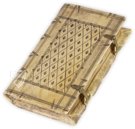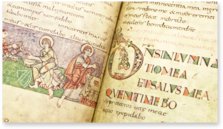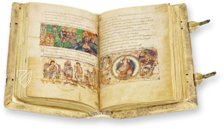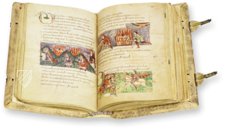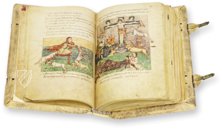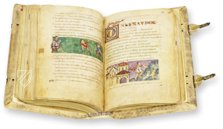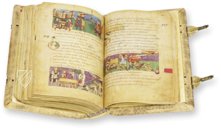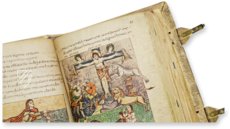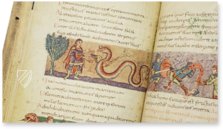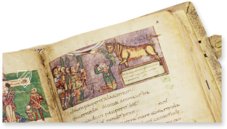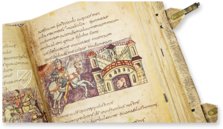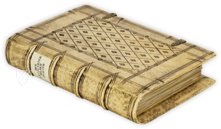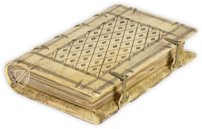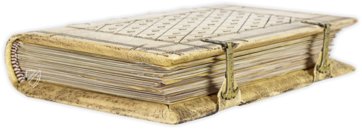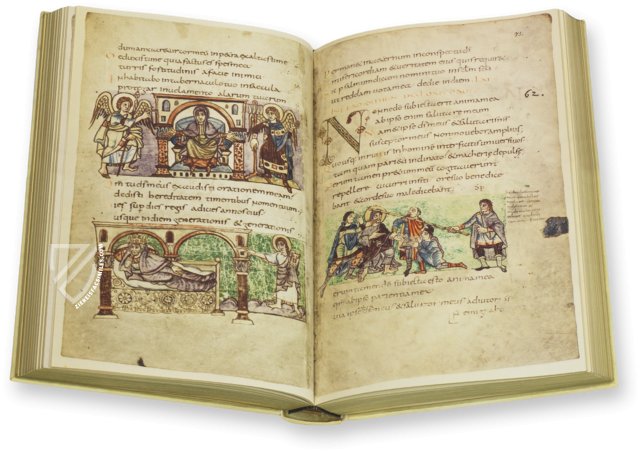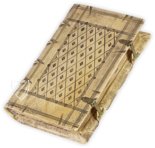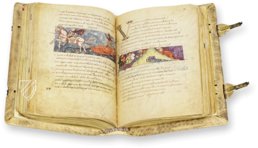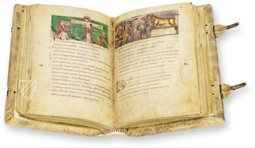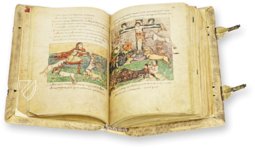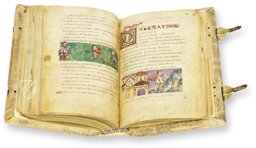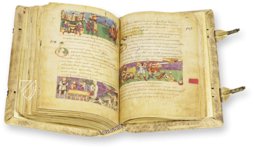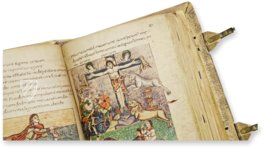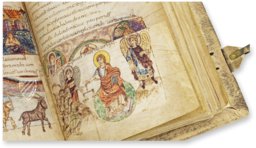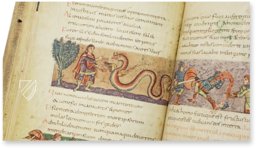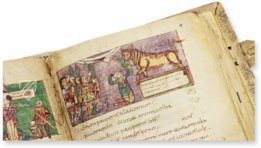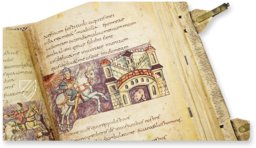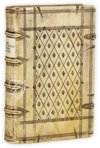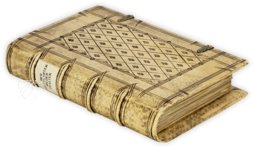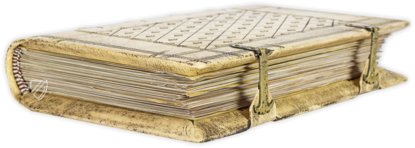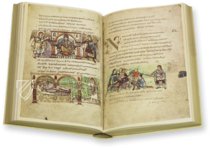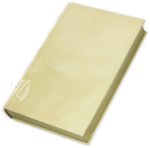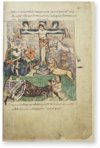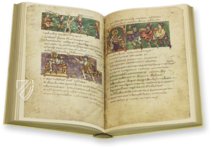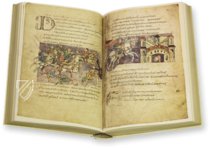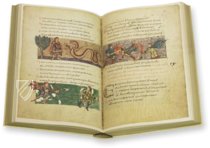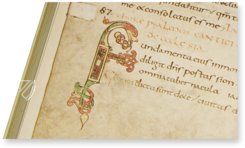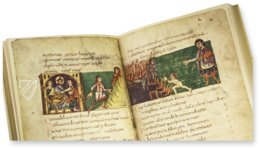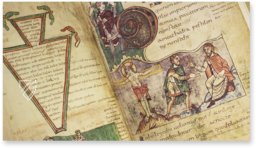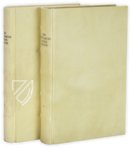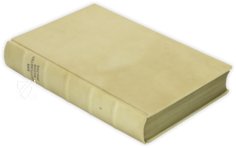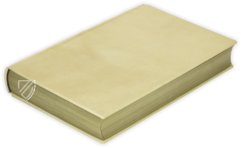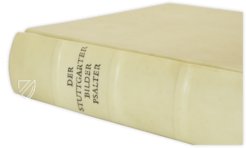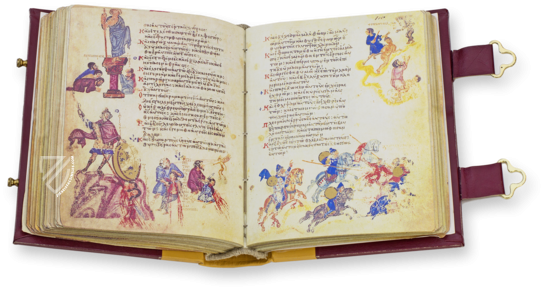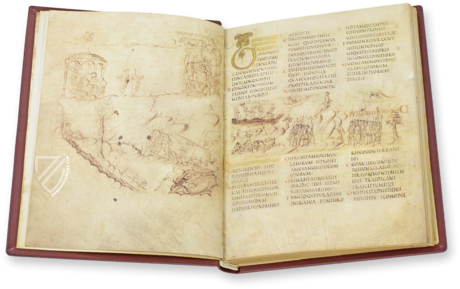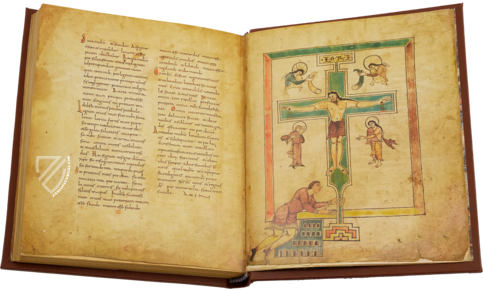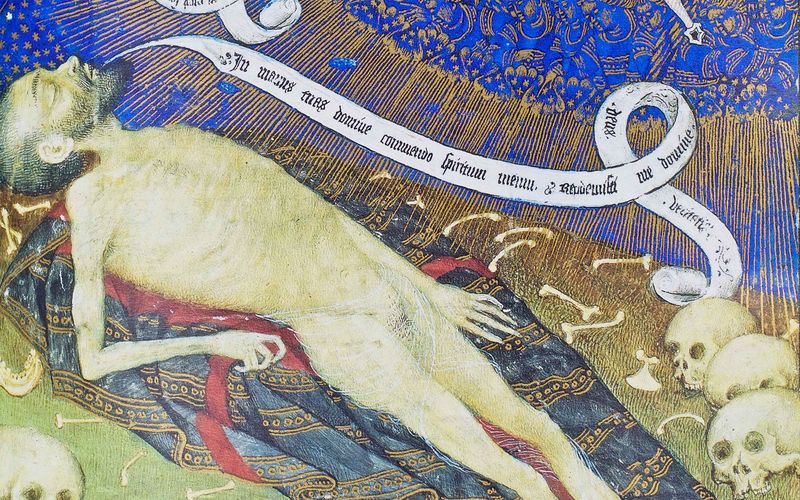Stuttgart Psalter
(3,000€ - 7,000€)
One can come up with a few superlatives Stuttgart Psalter straight away: the most important manuscript of the Württembergischen Landesbibliothek, the most richly illustrated Carolingian psalter of outstanding quality. Originating at the beginning of the 9th century in St. Germain-des- Prés, its provenance and history are wrapped in mystery. Nevertheless, since its scholarly discovery 1,000 years after its genesis, the manuscript of the Stuttgart Psalter amazes just about every connoisseur and lover of Carolingian illumination!
Stuttgart Psalter
A variety of gorgeous miniatures illustrate the Stuttgart Psalter, be it Christ on the cross as redeemer of mankind, an enthroned monarch before a grandiose backdrop, enigmatic scenes with fantastic beasts, or impressive depictions of everyday life. It is no coincidence that it is also famous as the so-called Stuttgart Picture-Psalter. Liveliness is probably the appropriate term for the gorgeous overall impression, which the numerous illustrative depictions evoke for the beholder.
A Psalter Rich in Imagery
The 150 Latin Psalms – important parts of Christian liturgy – are adorned with 316 miniatures and 162 initials on 300 pages. These illustrations stand firmly in the tradition of great Carolingian illumination. A few of the miniatures were probably based on ancient originals. Nonetheless, the visual adornment gives information about the time of the psalter’s genesis, e.g. an inside view into clothing and fashion. Individual motifs often overrun the edge of the framing background. This is not only an indication of the great master of their art who was at work here and innovatively conceived of and created an outstanding Carolingian illuminated manuscript.
A French Masterpiece
Whoever created this splendor remains unknown today. Nevertheless, it is generally agreed among researchers that the Stuttgart Psalteroriginated between 820 and 830 and is a masterpiece from the scriptorium of St. Germain-des-Prés in Paris. This important place of origin was the burial site for kings and the richest abbeys around Paris at that time. Yet even the patron and the circumstances of its genesis remain an unsolved mystery today, just like the further provenance of the psalter.
A Gift for the Prince Elector
The manuscript is named after its modern repository, the Württembergischen Landesbibliothek in Stuttgart. It probably came there at the end of the 18th century as a gift from Danial Gottlieb Friedrich Faber to Prince-Elector Carl Eugen von Württemberg, who had recently founded the library. 1,000 years after its creations, the manuscript finally enjoyed its due consideration and academic attention, e.g. a first description in the travelogue of an English librarian.
Admired and Coveted
The amazement and wonder with which the Stuttgart Psalter was met was not merely for its own benefit. In the course of the 20th century, the codex has been disassembled several times and presented in exhibitions and could only be elaborately restored for the first time a decade ago. Today, this gem of Carolingian illumination presents itself in its original luster.
Codicology
- Alternative Titles
- Stuttgart Picture Psalter
Stuttgarter Bilderpsalter
Psautier de Stuttgart - Size / Format
- 336 pages / 26.5 × 17.5 cm
- Origin
- France
- Date
- 820–830
- Epochs
- Style
- Genre
- Language
- Script
- Carolingian minuscule Roman Rustic Capitals
- Illustrations
- 316 colorful miniatures, 162 decorated initials
- Content
- Book of Psalms according to the Gallican Rite
- Previous Owners
- Charles II Duke of Wurtemberg
Daniel Gottlieb Friedrich Faber
Gottlieb Friedrich Faber
Stuttgart Psalter
Decorative Initial: Psalm 102
This is one of the Seven Penitential Psalms and is referred to in the Hebrew tradition as “a prayer for the afflicted”. Instead of having an incipit or large initial for the opening lines, the designer of this Psalter chose to highlight the following passage with an unusual and highly stylized “S” initial with the head of a heron and gold leaf: “I am like a pelican of the wilderness; I am like an owl of the desert. I lie awake, And am like a sparrow alone on the housetop.” (Psalm 102:7-8)

Stuttgart Psalter
Crucifixion
This unusual Crucifixion scene is split into two registers. Before a faded dark-blue background, Christ appears to stand more than hang on the cross. Although individual nails are depicted for each his feet, his hands are unpierced, as is his side, and his face is serene – he is Christ the King, already triumphant over death, as opposed to the more human, suffering Christ typically pictured.
Two soldiers sitting near the cross point out the angels who have appeared flanking the Messiah, while two more in the lower register fight over his discarded robes, one holding a knife. The most notable and unusual features of this miniature include a unicorn and lion, as well as an unusually muscular Christ with the pectoral muscles of a body builder.
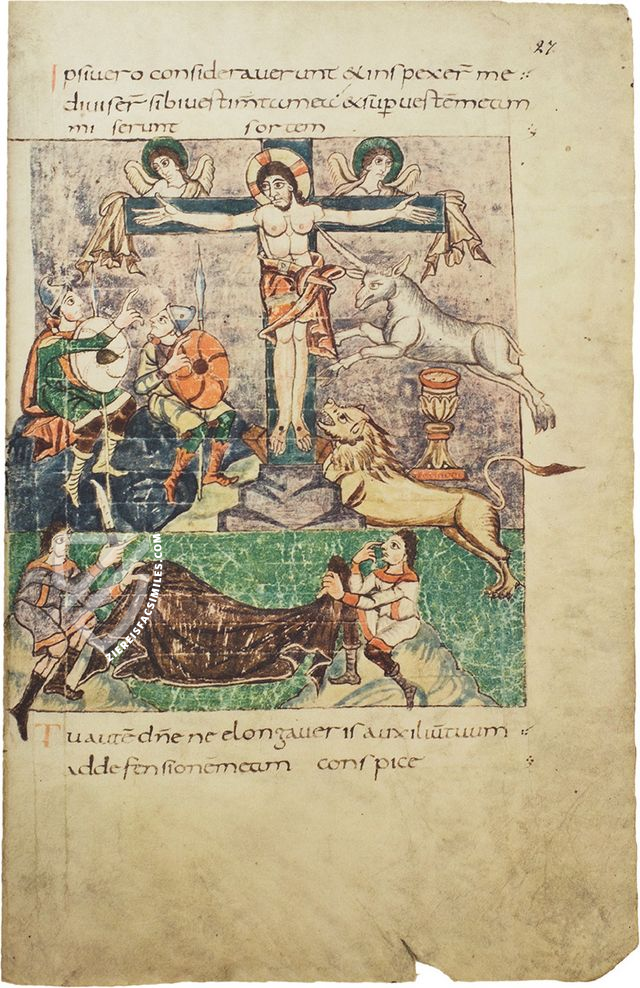
#1 Stuttgarter Bilderpsalter (Leather Edition)
Language: German
(3,000€ - 7,000€)
#2 Stuttgarter Bilderpsalter (Parchment Edition)
Language: German
(3,000€ - 7,000€)
- Treatises / Secular Books
- Apocalypses / Beatus
- Astronomy / Astrology
- Bestiaries
- Bibles / Gospels
- Chronicles / History / Law
- Geography / Maps
- Saints' Lives
- Islam / Oriental
- Judaism / Hebrew
- Single Leaf Collections
- Leonardo da Vinci
- Literature / Poetry
- Liturgical Manuscripts
- Medicine / Botany / Alchemy
- Music
- Mythology / Prophecies
- Psalters
- Other Religious Books
- Games / Hunting
- Private Devotion Books
- Other Genres
- Afghanistan
- Armenia
- Austria
- Belgium
- Belize
- Bosnia and Herzegovina
- China
- Colombia
- Costa Rica
- Croatia
- Cyprus
- Czech Republic
- Denmark
- Egypt
- El Salvador
- Ethiopia
- France
- Germany
- Greece
- Guatemala
- Honduras
- Hungary
- India
- Iran
- Iraq
- Israel
- Italy
- Japan
- Jordan
- Kazakhstan
- Kyrgyzstan
- Lebanon
- Liechtenstein
- Luxembourg
- Mexico
- Morocco
- Netherlands
- Palestine
- Panama
- Peru
- Poland
- Portugal
- Romania
- Russia
- Serbia
- Spain
- Sri Lanka
- Sweden
- Switzerland
- Syria
- Tajikistan
- Turkey
- Turkmenistan
- Ukraine
- United Kingdom
- United States
- Uzbekistan
- Vatican City
- A. Oosthoek, van Holkema & Warendorf
- Aboca Museum
- Ajuntament de Valencia
- Akademie Verlag
- Akademische Druck- u. Verlagsanstalt (ADEVA)
- Aldo Ausilio Editore - Bottega d’Erasmo
- Alecto Historical Editions
- Alkuin Verlag
- Almqvist & Wiksell
- Amilcare Pizzi
- Andreas & Andreas Verlagsbuchhandlung
- Archa 90
- Archiv Verlag
- Archivi Edizioni
- Arnold Verlag
- ARS
- Ars Magna
- ArtCodex
- AyN Ediciones
- Azimuth Editions
- Badenia Verlag
- Bärenreiter-Verlag
- Belser Verlag
- Belser Verlag / WK Wertkontor
- Benziger Verlag
- Bernardinum Wydawnictwo
- BiblioGemma
- Biblioteca Apostolica Vaticana (Vaticanstadt, Vaticanstadt)
- Bibliotheca Palatina Faksimile Verlag
- Bibliotheca Rara
- Boydell & Brewer
- Bramante Edizioni
- Bredius Genootschap
- Brepols Publishers
- British Library
- C. Weckesser
- Caixa Catalunya
- Canesi
- CAPSA, Ars Scriptoria
- Caratzas Brothers, Publishers
- Carus Verlag
- Casamassima Libri
- Centrum Cartographie Verlag GmbH
- Chavane Verlag
- Christian Brandstätter Verlag
- Circulo Cientifico
- Club Bibliófilo Versol
- Club du Livre
- CM Editores
- Collegium Graphicum
- Collezione Apocrifa Da Vinci
- Comissão Nacional para as Comemorações dos Descobrimentos Portugueses
- Coron Verlag
- Corvina
- CTHS
- D. S. Brewer
- Damon
- De Agostini/UTET
- De Nederlandsche Boekhandel
- De Schutter
- Deuschle & Stemmle
- Deutscher Verlag für Kunstwissenschaft
- DIAMM
- Droz
- E. Schreiber Graphische Kunstanstalten
- Ediciones Boreal
- Ediciones Grial
- Ediclube
- Edições Inapa
- Edilan
- Editalia
- Edition Deuschle
- Edition Georg Popp
- Edition Leipzig
- Edition Libri Illustri
- Editiones Reales Sitios S. L.
- Éditions de l'Oiseau Lyre
- Editions Medicina Rara
- Editorial Casariego
- Editorial Mintzoa
- Editrice Antenore
- Editrice Velar
- Edizioni Edison
- Egeria, S.L.
- Eikon Editores
- Electa
- Emery Walker Limited
- Enciclopèdia Catalana
- Eos-Verlag
- Ephesus Publishing
- Ernst Battenberg
- Eugrammia Press
- Extraordinary Editions
- Fackelverlag
- Facsimila Art & Edition
- Facsimile Editions Ltd.
- Facsimilia Art & Edition Ebert KG
- Faksimile Verlag
- Feuermann Verlag
- Folger Shakespeare Library
- Franco Cosimo Panini Editore
- Friedrich Wittig Verlag
- Fundación Hullera Vasco-Leonesa
- G. Braziller
- Gabriele Mazzotta Editore
- Gebr. Mann Verlag
- Gesellschaft für graphische Industrie
- Getty Research Institute
- Giovanni Domenico de Rossi
- Giunti Editore
- Graffiti
- Grafica European Center of Fine Arts
- Guido Pressler
- Guillermo Blazquez
- Gustav Kiepenheuer
- H. N. Abrams
- Harrassowitz
- Harvard University Press
- Helikon
- Hendrickson Publishers
- Henning Oppermann
- Herder Verlag
- Hes & De Graaf Publishers
- Hoepli
- Holbein-Verlag
- Houghton Library
- Hugo Schmidt Verlag
- Idion Verlag
- Il Bulino, edizioni d'arte
- ILte
- Imago
- Insel Verlag
- Instituto de Estudios Altoaragoneses
- Instituto Nacional de Antropología e Historia
- Istituto dell'Enciclopedia Italiana - Treccani
- Istituto Ellenico di Studi Bizantini e Postbizantini
- Istituto Geografico De Agostini
- Istituto Poligrafico e Zecca dello Stato
- Italarte Art Establishments
- Jan Thorbecke Verlag
- Johnson Reprint Corporation
- Josef Stocker
- Josef Stocker-Schmid
- Jugoslavija
- Karl W. Hiersemann
- Kasper Straube
- Kaydeda Ediciones
- Kindler Verlag / Coron Verlag
- Kodansha International Ltd.
- Konrad Kölbl Verlag
- Kurt Wolff Verlag
- La Liberia dello Stato
- La Linea Editrice
- La Meta Editore
- Lambert Schneider
- Landeskreditbank Baden-Württemberg
- Leo S. Olschki
- Les Incunables
- Liber Artis
- Library of Congress
- Libreria Musicale Italiana
- Lichtdruck
- Lito Immagine Editore
- Lumen Artis
- Lund Humphries
- M. Moleiro Editor
- Maison des Sciences de l'homme et de la société de Poitiers
- Manuscriptum
- Martinus Nijhoff
- Maruzen-Yushodo Co. Ltd.
- MASA
- Massada Publishers
- McGraw-Hill
- Metropolitan Museum of Art
- Militos
- Millennium Liber
- Müller & Schindler
- Nahar - Stavit
- Nahar and Steimatzky
- National Library of Wales
- Neri Pozza
- Nova Charta
- Oceanum Verlag
- Odeon
- Orbis Mediaevalis
- Orbis Pictus
- Österreichische Staatsdruckerei
- Oxford University Press
- Pageant Books
- Parzellers Buchverlag
- Patrimonio Ediciones
- Pattloch Verlag
- PIAF
- Pieper Verlag
- Plon-Nourrit et cie
- Prestel Verlag
- Princeton University Press
- Prisma Verlag
- Priuli & Verlucca, editori
- Pro Sport Verlag
- Propyläen Verlag
- Pytheas Books
- Quaternio Verlag Luzern
- Reales Sitios
- Recht-Verlag
- Reichert Verlag
- Reichsdruckerei
- Reprint Verlag
- Riehn & Reusch
- Roberto Vattori Editore
- Rosenkilde and Bagger
- Roxburghe Club
- Salerno Editrice
- Saltellus Press
- Sandoz
- Sarajevo Svjetlost
- Schöck ArtPrint Kft.
- Schulsinger Brothers
- Scolar Press
- Scrinium
- Scripta Maneant
- Scriptorium
- Shazar
- Siloé, arte y bibliofilia
- SISMEL - Edizioni del Galluzzo
- Sociedad Mexicana de Antropología
- Société des Bibliophiles & Iconophiles de Belgique
- Soncin Publishing
- Sorli Ediciones
- Stainer and Bell
- Studer
- Styria Verlag
- Sumptibus Pragopress
- Szegedi Tudomànyegyetem
- Taberna Libraria
- Tarshish Books
- Taschen
- Tempus Libri
- Testimonio Compañía Editorial
- Thames and Hudson
- The Clear Vue Publishing Partnership Limited
- The Facsimile Codex
- The Folio Society
- The Marquess of Normanby
- The Richard III and Yorkist History Trust
- Tip.Le.Co
- TouchArt
- TREC Publishing House
- TRI Publishing Co.
- Trident Editore
- Typis Regiae Officinae Polygraphicae
- Union Verlag Berlin
- Universidad de Granada
- University of California Press
- University of Chicago Press
- Urs Graf
- Vallecchi
- Van Wijnen
- VCH, Acta Humaniora
- VDI Verlag
- VEB Deutscher Verlag für Musik
- Verlag Anton Pustet / Andreas Verlag
- Verlag Bibliophile Drucke Josef Stocker
- Verlag der Münchner Drucke
- Verlag für Regionalgeschichte
- Verlag Styria
- Vicent Garcia Editores
- W. Turnowski Ltd.
- W. Turnowsky
- Waanders Printers
- Wiener Mechitharisten-Congregation (Wien, Österreich)
- Wissenschaftliche Buchgesellschaft
- Wissenschaftliche Verlagsgesellschaft
- Wydawnictwo Dolnoslaskie
- Xuntanza Editorial
- Zakład Narodowy
- Zollikofer AG





